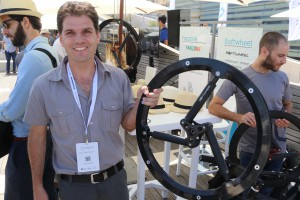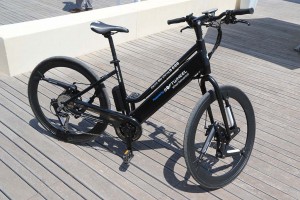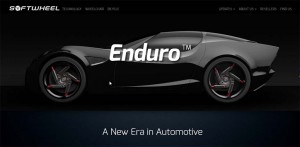Daniel Barel wants to reinvent the wheel. Actually, he’s quick to tell you he already has.
The young Israeli entrepreneur is CEO of a Tel Aviv-based start-up called Softwheel that has come up with a new concept that could, Barel boasts, improve the comfort, handling and even the fuel economy of virtually any wheeled vehicle. And it happened largely by accident.
“We didn’t intend to reinvent the wheel,” says Barel, whose company is one of dozens of start-ups participating in an Israeli automotive tech fair called EcoMotion on a warm and blindingly sunny afternoon along the Mediterranean coast. “It started as an accident.”
(Israeli start-up developing battery you fill up, rather than charging. Click Here for more.)
Softwheel’s original mission, backed by an Israeli government grant, was to come up with a better wheelchair. Barel’s team spent several years trying to perfect current designs and couldn’t come up with an improved design. Finally, the company was told it would be shut down in six months if it didn’t have a breakthrough.
That’s when inspiration struck. Instead of looking at the chair portion, Softwheel engineers realized “it was the wheel” they could improve. Luckily, Barel recalls, the team didn’t bother to check the web to see if their inspiration would work. The idea they came up with had been tried for at least 200 years and never seemed to work.
The concept was, at first blush, simple: instead of pairing the wheel with an external suspension system, Softwheel replaced the wheel’s spokes with three shock absorbers.
A bicycle brought by Softwheel to the conference illustrates the idea. As a rider starts to pedal, the bike runs into a large chunk of concrete, something that would normal cause it – and the rider – to lurch unsteadily. Instead, the wheel deflects the impact and the bike and rider roll ahead as if on a sheet of glass.
The design allows a wheelchair to climb or descend stairs, as well, without tossing out its rider. That was a personal challenge for Softwheel product specialist Dror Cohen, an Israeli Air Force veteran who has been wheelchair-bound for 24 years since being injured in a car crash.
(Volvo unveils new XC40 and S40 concept vehicles. Click Here to check them out.)
But Barel claims the Softwheel design could be used for just about anything with wheels big enough to fit shock absorbers inside, from mopeds to motorcycles, even an automobile. The start-up has even put a five-shock wheel on a concept sports car it has dubbed the Enduro. The CEO claims the company’s wheel could essentially eliminate an automobile’s conventional suspension system, though it remains to be seen if it would really be robust enough to handle the stresses faced by a sports car.
By smoothing over even the roughest pavement, the Softwheel also reduces the amount of energy needed to move a wheeled vehicle, at least according to data the company has compiled. One study indicated an electric bike consumed an average of about 16% less power to manage a trek that included a mix of different conditions including both smooth and rough pavement, as well as a hill climb.
Softwheel has already delivered a number of its wheelchairs, including 100 provided U.S. military veterans through the non-profit Indy Fund.
Meanwhile, it is rapidly ramping up production of a bicycle wheel, with three factories now in operation, including a facility in North Carolina, as well as one in Israel and another in the Czech Republic. Softwheel is planning two more, one likely to open somewhere along the U.S. West Coast, Barel hints.
The wheels are offered in various sizes, and they are being produced in three different forms using either aero-grade aluminum, pure magnesium or carbon fiber. Traditional pneumatic tires, meanwhile, are replaced by solid rubber with a foam filling that reduces the softwheel’s overall mass.
A set of wheels for a wheelchair go for $1,500 to $2,500. For a bicycle, the price can reach $3,000, depending upon the material. Softwheel is also preparing to provide wheels at a higher volume and lower price point for some urban bike-sharing programs.
Meanwhile, Softwheel also is talking to several potential partners, including Michelin, though an industry source cautions that the French tire giant has a breakthrough wheel of its own design, the Tweel, that it is trying to perfect.
“We can make our wheel lighter, simpler and more energy-efficient,” concludes Barel.
It isn’t a better mousetrap, but the Israeli entrepreneur is confident that a better wheel also will have beating a path to his company’s door.
(Competition heating up to develop autonomous heavy trucks. Click Here for the latest.)




Wow. If this is scalable to cars, revolutionary
Three issues: 1) In the picture shown, there are 120 degrees of unsupported wheel; 2) The vehicle load will always deflect the springs/dampers with every rotation (and waste energy); 3) High rotational mass.
To address point two, Dave, the vehicle load is spread out and does not deflect the springs/dampers at all. I watched as people got on and off the electric bike and there was no deflection in any way. The offset mounting of the shocks vis a vis the center hub appear to be critical. Same as to why it reduces, rather than wastes energy. I have seen the data and validated it with someone that has much more knowledge about suspension engineering than I have.
Paul E.
Paul, Are these simply shock absorbers, or are they a spring/shock combo like a automotive strut? I could readily see the soft-ride, compliant suspension aspect of the “Softwheel,” but I wonder about applying torque to the wheel hub (as in the drive wheel of an automobile)… the three shock absorbers will transmit torque from the axle center through to the rim and tire; acceleration will compress the shocks (in one direction), braking (if applied with a disc assembly at the hub) will put the shocks into rebound and add some slop to the driveline. Perhaps an additional threesome of shocks mounted on the other side of the Softwheel, but offset on the hub in the opposite direction from the first set.
Paul, Does this “Softwheel” outfit have a website? Or a source of more technical information? This is interesting…
Hi, Gene,
My understanding is that it is a spring/shock combo. I’m afraid my technical expertise on suspension technology is somewhat limited. Here’s the company’s website: http://softwheel.technology/
Paul E.